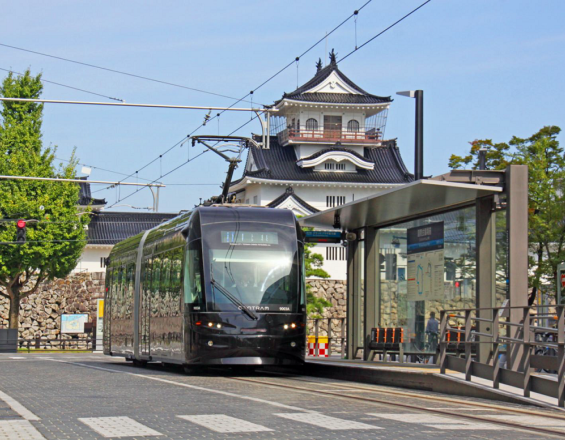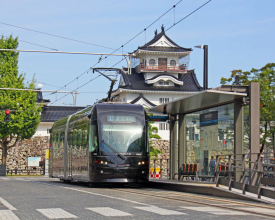
Transformation to a Compact City through Light Rail Transit

Toyama has developed as one of the main capital cities along the coastal region of the Japan Sea. The city area of 1,242 km2 with about 420,000 residents accounts for approximately 30% of the prefectural land. However, the prefectural capital experienced both a shrinking population, having reached a peak in 2010, and also aging, with a high proportion of elderly residents estimated to reach about 30% by 2020 (Figure 1 and 2). Due to the shrinking and aging population trends within its large municipal boundary, the city had the lowest urban density among all prefectural capitals in Japan. In response to increased social concern over these demographic and urban declining issues, the city adopted a strategy to tarnsform itself to a transit-oriented, compact township by reinvesting in public transit systems and consolidating a wide range of city functions along the modernized transit corridors.
Contexto
Défis à relever
The prefectural capital experienced both a shrinking population, having reached a peak in 2010, and also aging, with a high proportion of elderly residents estimated to reach about 30% by 2020. Due to the shrinking and aging population trends within its large municipal boundary, the city marked the lowest urban density among all prefectural capitals in Japan. Similar to many American cities, Toyama’s spacious and flat land market, strong demand for home ownership, and extended road network has accelerated urban sprawl and exacerbated downtown decay over the past decades. Accordingly, Toyama’s lifestyle became heavily car dependent with the second highest private vehicle ownership in the country (1.72 cars per household in 2010.
Ubicación
Procesar
Summary of the process
Toyama's approach to first set a long-term vision by the Mayor which is shared through citizens through close citizen engagement and consultation was realized by a suite of operational programs which allowed the city to transform itself to a transit-oriented city with a vital city center. More specifically, land use incentives were applied to bring people back to the city center, and at the same time, the city ensured to meet the expectations of these people - through investing not only in the commercial business district at the core and housing development along the corridors, but also ensuring high-quality public transit services that connect these areas well.
Building Blocks
Long-term Vision from Mayor Shared by Citizens
Holding one iconic vision with all citizens is essential to make long-term efforts in tarnsforming a city structure and synchronizing a variety of individual capital projects and operation programs delivered by several public-private stakeholders.
Enabling factors
- Strong committment from the Mayor
- Frequent and continuous opportunities for dialogue with the citizens to transform the city's development vision into a "shared" vision by the people
- Detailed operational programs to translate the vision to step-by-step actions
Lesson learned
In order to transform a vision into reality, (1) Capital Projects with Multiple Funding Sources and (2) Successive Operation Programs is key.
More specifically:
Capital Projects with Multiple Funding Sources: The vision of forming a compact city inevitably calls for major capital projects, such as public transit reinvestments and social infrastructure improvements. Small cities and peripheral towns under severe budget constraints need to combine multiple funding sources efficiently and consistently into a project finance scheme.
Successive Operation Programs:
The provision of modern infrastructure alone does not automatically lead to urban regeneration. “Placemaking” efforts need to be made for inducing value-added social interactions in the long run. Individual business owners and local commercial associations play a vital role in successively implementing a variety of urban operation and district management programs together with municipal governments and transit agencies.
Land Use Incentives
Under a market freehold system, it is not always easy for local planning departments to curb large shopping mall projects and gain control over individual land uses by zoning. When and where traditional planning and regulatory systems are not sufficient to manage land use and shape development, generous incentives (e.g., direct subsidies, tax reductions, and expedited reviews) may be needed to move new residents to the target districts and corridors.
Enabling factors
- Substantial assistance from the city government to provide direct subsidies, tax reductions and expedited reviews
Lesson learned
It is critical for local governments to identify major property owners and involve powerful private developers in both capital projects and operation programs that aim to materialize the public vison of building a compact city in a profitable way.
Reinvestment in Public Transit
The city introduced Japan’s first light rail transit (LRT), called PORTRAM, by utilizing the former JR Toyama-port line’s right of way accompanied by the extension of bullet train services to Toyama Station. The PORTRAM system with barrier-free stations and low-floor vehicles over the operation length of 7.6 km can smoothly carry elderly and disabled passengers to a variety of city destinations and bring wider environmental benefits, such as reduction in noise, air pollution, and CO2 emissions, to the whole city. Importantly, innovative project finance schemes were applied to split the roles of railway construction and system operation between public and private partners for the Toyama LRT. The public sector covers all the construction cost of the LRT system, including vehicles, railways, and depots, and the maintenance cost of these facilities, whereas the transit operator founded by several local governments and private companies recovers operation costs from fare revenues. The city filled the capital funding gap by arranging the national government’s road improvement programs and contributions from transit companies and by saving land acquisition costs with the former JR railway’s right of way.
Enabling factors
- Attention to universal accessibility for all
- Innovative project finance schemes for public-private partnership
- Sufficient funding support from the city
Lesson learned
Caveat of applying this approach is that specifically for the Toyama case, the city had sufficient funds to cover construction cost of the LRT system, including vehicles, railways, and depots, and the maintenance cost of these facilities. Utilizing right of ways of previous public transport systems can also be useful.
Promotion of New Township along the Public Transit Corridors
The city designated 436 hectares for an urban core district, 19 public transit corridors (including both light rail transit and bus lines), and 3,489 hectares for residential promotion areas along the corridors, for which special subsidies became available for qualified home builders, new housing owners, and multi-family apartment residents. Consequently, the number of new residential properties along the promoted transit lines increased 1.32 times for the period of 2004 to 2009.
Enabling factors
- Financial incentives for home owners along the public transit corridors
- Commercial facilities, schools, hospitals etc. available within walking distance from public transit nodes and stations
Lesson learned
Toyama's approach to attract development along the public transit corridors proved successful especially when this was backed by financial incentives. This in turn has led to indirectly disincentivising living in city fringe areas.
City Core Revitalization
The city applied a variety of capital improvement projects and urban operation schemes for city core revitalization. A centerpiece of the revitalization package is the development of Grand Plaza – a major social open space equipped with audio-visual amenities for various events and covered by a high-ceiling glass roof under all-weather conditions, in particular to deal with Toyama’s heavy snowfall climate. The city also established a 24-hour bicycle-sharing system by placing 17 bike stations with a private operator in the city core district. A central marketplace and local community facilities were constructed through the unique redevelopment schemes and incentive arrangement.
Enabling factors
- Development of a centric multifunctional facility to attract citizens and visitors (Grand Plaza)
- Consideration to local climate and environment in the facility design
Lesson learned
The key to the success of the city core revitalization is the wide variety of activity offerings suited for all generations, with due attention to the socially vulnerable, e.g. elderly, children, expecting mothers. The LRT supports this by providing direct and safe access from homes for this cohort of the population as well.
Impacts
Economic Impact: The city’s local economy was largely revitalized by the extended transit access. A number of commercial and tourist facilities along the corridor attracted more visitors after the LRT line started operation (e.g., a national important cultural site saw a 3.5 times increase in the number of visitors). Moreover, the average land price in the city and its commercial districts increased 0.2% and 0.8% for the period of July 2013 to July 2014, respectively, despite the fact that the entire prefecture continuously dropped its average land price over the past two decades.
Social Impact: The reinvested public transit (or light rail transit) system resulted in a 2.1 times increase to its ridership in weekdays and a 3.4 times increase at the weekends. In particular, Toyama’s elderly people went out more frequently during the daytime. More households began to live in the city core district and the promoted residential areas along the public transit corridors.
Environmental Impact: Approximately 12% of the rail transit users had switched from private cars, thus contributing to Toyama’s CO2 emission reduction at the rate of 74 tons per year. Toyama was listed as one of the locations with the best practices of building compact cities in 2012, together with Melbourne, Vancouver, Paris, and Portland, by the Organizations for Economic Co-operation and Development (OECD).
Beneficiaries
- Residents of Toyama City
- Local stores and land owners






